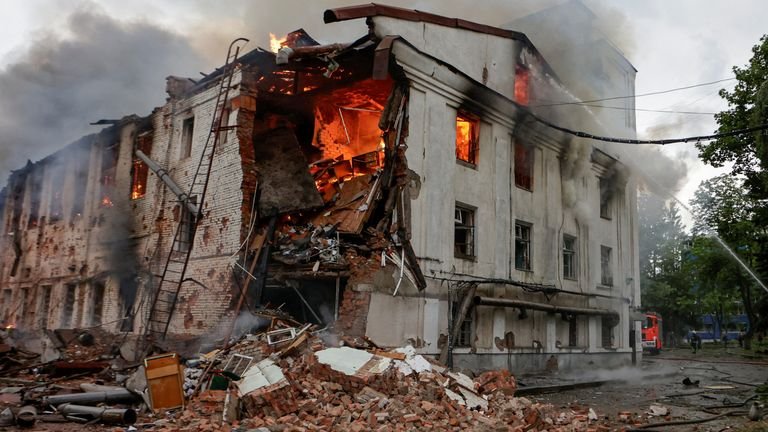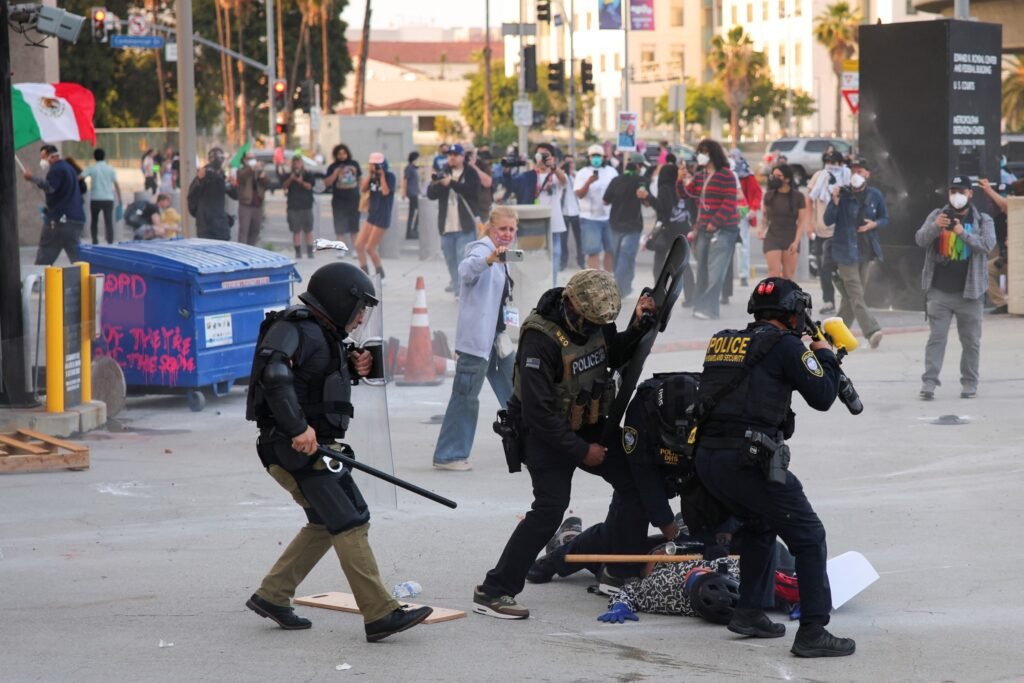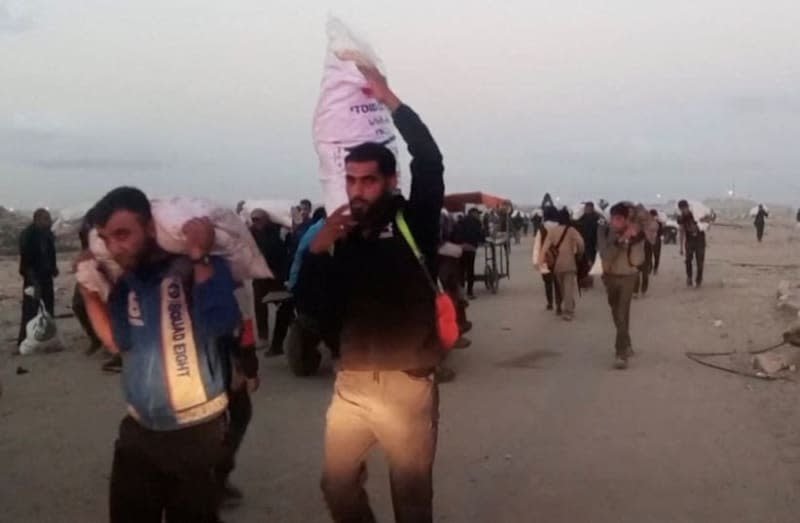More than a decade ago, Mexican authorities erected a billboard along the border in Ciudad Juárez, across the Rio Grande from El Paso.
“No More Weapons,” was the stark message, written in English and crafted from 3 tons of firearms that had been seized and crushed.
It was a desperate entreaty to U.S. officials to stanch the so-called Iron River, the southbound flow of arms that was fueling record levels of carnage in Mexico.
But the guns kept coming — and the bloodletting and mayhem grew.
Finally, with homicides soaring to record levels, exasperated authorities pivoted to a novel strategy: Mexico filed a $10-billion suit in U.S. federal court seeking to have Smith & Wesson and other signature manufacturers held accountable for the country’s epidemic of shooting deaths.
The uphill battle against the powerful gun lobby survived an appeals court challenge, but last week the U.S. Supreme Court threw out Mexico’s lawsuit, ruling unanimously that federal law shields gunmakers from nearly all liability.
Read more: So what really happened at the cartel training site dubbed ‘Mexican Auschwitz’?
Although the litigation stalled, advocates say the high-profile gambit did notch a significant achievement: Dramatizing the role of Made-in-U.S.A. arms in Mexico’s daily drumbeat of assassinations, massacres and disappearances.
“Notwithstanding the Supreme Court ruling, Mexico’s lawsuit has accomplished a great deal,” said Jonathan Lowy, president of Global Action on Gun Violence, a Washington-based advocacy group.
“It has put the issue of gun trafficking — and the industry’s role in facilitating the gun pipeline — on the bilateral and international agenda,” said Lowy, who was co-counsel in Mexico’s lawsuit.
Read more: Supreme Court throws out Mexico’s suit against U.S. gun makers in a unanimous decision
A few hours after the high court decision, Ronald Johnson, the U.S. ambassador in Mexico City, wrote on X that the White House was intent on working with Mexico “to stop southbound arms trafficking and dismantle networks fueling cartel violence.”
The comments mark the first time that Washington — which has strong-armed Mexico to cut down on the northbound traffic of fentanyl and other illicit drugs — has acknowledged a reciprocal responsibility to clamp down on southbound guns, said President Claudia Sheinbaum. She hailed it as a breakthrough, years in the making.
“This is not just about the passage of narcotics from Mexico to the United States,” Sheinbaum said Friday. “But that there [must] also be no passage of arms from the United States to Mexico.”

Vigilante fighters in Guerrero state in 2019. The vast majority of guns in circulation in Mexico originated in the United States. (Gary Coronado / Los Angeles Times)
Mexico is mulling options after the Supreme Court rebuff, Sheinbaum said. Still pending is a separate lawsuit by Mexico in U.S. federal court accusing five gun dealers in Arizona of trafficking weapons and ammunition to the cartels.
Read more: Indigenous activist’s disappearance and killing cause outcry in Mexico’s Oaxaca state
Meanwhile, U.S. officials say that the Trump administration’s recent designation of six Mexican cartels as foreign terrorist organizations means that weapons traffickers may face terrorism-related charges.
“In essence, the cartels that operate within Mexico and threaten the state are armed from weapons that are bought in the United States and shipped there,” U.S. Secretary of State Marco Rubio told a congressional panel last month. “We want to help stop that flow.”
On Monday, federal agents gathered at an international bridge in Laredo, Texas, before an array of seized arms — from snub-nosed revolvers to mounted machine guns — to demonstrate what they insist is a newfound resolve to stop the illicit gun commerce.
“This isn’t a weapon just going to Mexico,” Craig Larrabee, special agent in charge of Homeland Security Investigations in San Antonio, told reporters. “It’s going to arm the cartels. It’s going to fight police officers and create terror throughout Mexico.”
Read more: Trump wants to attack drug cartels. How can Mexico respond if he does?
In documents submitted to the Supreme Court, Mexican authorities charged that it defied credibility that U.S. gunmakers were unaware that their products were destined for Mexican cartels — a charge denied by manufacturers.
The gun industry also disputed Mexico’s argument that manufacturers deliberately produce military-style assault rifles and other weapons that, for both practical and aesthetic reasons, appeal to mobsters. Mexico cited several .38-caliber Colt offerings, including a gold-plated, Jefe de Jefes (“Boss of Bosses”) pistol; and a handgun dubbed the “Emiliano Zapata,” emblazoned with an image of the revered Mexican revolutionary hero and his celebrated motto: “It is better to die standing than to live on your knees.”

A soldier at the Directorate of Arms and Munitions Sales, one of two stores in Mexico where people can legally purchase guns. (Meghan Dhaliwal / For The Times)
Compared with the United States, Mexico has a much more stringent approach to firearms.
Like the 2nd Amendment, Mexico’s Constitution guarantees the right to bear arms. But it also stipulates that federal law “will determine the cases, conditions, requirements and places” of gun ownership.
There are just two stores nationwide, both run by the military, where people can legally purchase guns. At the bigger store, in Mexico City, fewer than 50 guns are sold on average each day.
Buyers are required to provide names, addresses and fingerprints in a process that can drag on for months. And unlike the United States, Mexico maintains a national registry.
But the vast availability of U.S.-origin, black-market weapons undermines Mexico’s strict guidelines.

Thousands of guns are destroyed in Ciudad Juarez, Mexico, in 2012. At least 6,000 rifles and pistols seized from drug cartels were destroyed by the Mexican army. (Jesus Alcazar / AFP via Getty Images)
According to Mexican officials, an estimated 200,000 to half a million guns are smuggled annually into Mexico.
Data collected by the U.S. Bureau of Alcohol, Tobacco, Firearms and Explosives illustrate where criminals in Mexico are obtaining their firepower.
Of the 132,823 guns recovered at crime scenes in Mexico from 2009 to 2018, fully 70% were found to have originated in the U.S. — mostly in Texas and other Southwest border states.
In their lawsuit, Mexican authorities cited even higher numbers: Almost 90% of guns seized at crime scenes came from north of the border.
Experts say most firearms in Mexico are bought legally at U.S. gun shows or retail outlets by so-called straw purchasers,who smuggle the weapons across the border. It’s a surprisingly easy task: More than a million people and about $1.8 billion in goods cross the border legally each day, and Mexico rarely inspects vehicles heading south.
In recent years, the flood of weapons from the United States has accelerated, fueling record levels of violence. Mexican organized crime groups have expanded their turf and moved into rackets beyond drug trafficking, including extortion, fuel-smuggling and the exploitation of timber, minerals and other natural resources.
In 2004, guns accounted for one-quarter of Mexico’s homicides. Today, guns are used in roughly three-quarters of killings.
Mexican leaders have long been sounding alarms.
Former President Felipe Calderón, who, with U.S. backing, launched what is now widely viewed as a catastrophic “war” on Mexican drug traffickers in late 2006, personally pleaded with U.S. lawmakers to reinstate a congressional prohibition on purchases of high-powered assault rifles. The expiration of the ban in 2004 meant that any adult with a clean record could enter a store in most states and walk out with weapons that, in much of the world, are legally reserved for military use.

A gun dealer in Mexico City, who requested anonymity, resells smuggled weapons he buys on the black market. Firearms trafficked to Mexico are bought legally in the U.S. and easily moved south. (Gary Coronado / Los Angeles Times)
“Many of these guns are not going to honest American hands,” Calderon said in a 2010 address to the U.S. Congress. “Instead, thousands are ending up in the hands of criminals.”
It was Calderón who, near the end of his term, ventured to the northern border to unveil the massive billboard urging U.S. authorities to stop the weapons flow.
His appeals, and those of subsequent Mexican leaders, went largely unheeded. The verdict is still out on whether Washington will follow up on its latest vows to throttle the gun traffic.
“The Trump administration has said very clearly that it wants to go after Mexican organized crime groups,” said David Shirk, a political scientist at San Diego University who studies violence in Mexico. “And, if you’re going to get serious about Mexican cartels, you have to take away their guns.”
Special correspondent Cecilia Sánchez Vidal contributed to this report.
This story originally appeared in Los Angeles Times.







